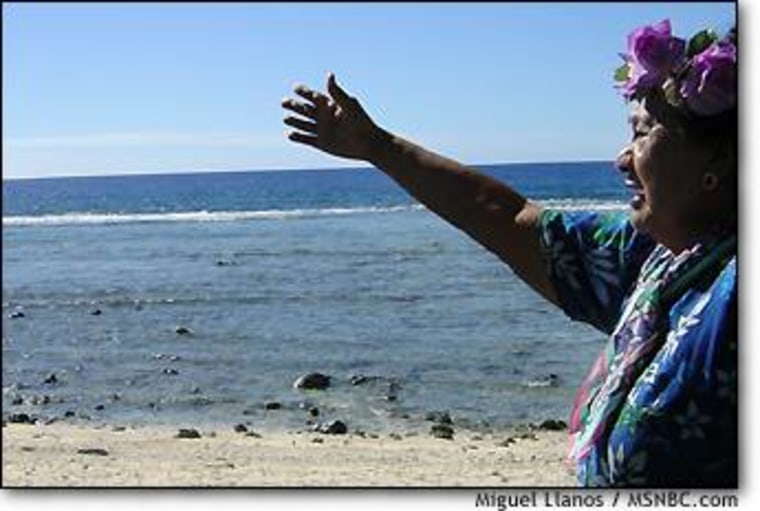Tamarua Nui loves her piece of paradise in the South Pacific. She’s also partly responsible for protecting it. The retired school teacher didn’t expect to have that job, but when she inherited the title of community elder from her father she also inherited a task facing most nations in this region: protecting the fish and coral that surround these islands and give them their underwater beauty.
NUI MIGHT not be in the majority, but neither is she alone. More and more islanders are taking matters into their own hands, using traditions to institute bans or limits on what is caught along their seashores — the homes to reef fish and the coral that feeds them.
The threats are varied. One is overfishing, both by locals and foreigners. In some countries that includes using dynamite and poison to flush the fish out from the coral.
“In some communities they see coral just as rock, and they treat it that way,” says Alifereti Tawake, a researcher at the University of the South Pacific.
Another threat is farming or construction that sends sediment into the water, choking coral reefs. And then there are climate shifts, where a difference of 1 degree in water temperature can play havoc with reefs.
‘RAUI’ REDISCOVERED
On the Cook Islands, a nation just east of Tahiti, Nui’s village and four others in 1998 rediscovered the power of “raui,” a traditional system whereby local leaders institute a temporary ban on using a local resource. Today, protected marine areas are known as raui and usually extend just beyond a reef, protecting the shallow lagoons that surround Raratonga, the main island.
“Our ancestors knew how to do these things so why can’t we do it today,” Nui and others asked when it became clear that fewer, and smaller, fish were being caught.
The 72-year-old woman also recalls that because the raui had last been used in 1950, younger villagers had no concept of it. “There was resistance because the younger generation didn’t know what raui meant,” she says. “They didn’t realize that in those days the fish were bigger and they weren’t scarce.”
Those skeptics “aren’t talking now,” she says, after a recent government survey found a tremendous rebound in just two years: 31 species of fish — twice as many as before — and 20 times the population.

COMMUNITY EFFORT
The World Wildlife Fund gets credit for planting the raui idea, and the Cook Islands government has pitched in with studies and by paying for raui warning signs around the island.
But the return of the raui has worked only because local elders adopted it, holding regular meetings and bringing in others, including landowners and even the churches on this very religious island.
“You know how people react, sometimes they get jealous” if they’re left out, Nui says. “We don’t want to encourage that type of feelings.”
In Nui’s village, a local church blessed the ceremony reinstituting the raui and a community feast was held.
Deeply religious herself, Nui nonetheless acknowledges that organized religion has eroded some local traditions. Sometimes it takes away something we really treasure,” she says. The raui, on the other hand, reflect a renaissance in which the church is a partner.
Nui says she’s only had two run-ins since the raui was established. In both cases, women were collecting trochus, a marine snail valued for its meat. She scolded the violators, saying “Don’t let me find you here again.”
“Sometimes I feel like going to court,” she says, “but I want to keep the traditions.”
As she spoke, an empty trochus shell appeared on the beach. “We don’t have a patrol,” she says, “and the people who live here are working so they can’t see everything.”
But that’s the way of the raui. “We don’t want a war,” she says, “it’s about community action.”
NETWORKING THE IDEA
The rebirth of local traditions is also taking place on other South Pacific islands, with Fiji and Palau held up as prime examples.
Researchers at the University of the South Pacific, whose main campus is on Fiji, have been closely watching a local project where village chiefs declared bans on fishing.
There too, says marine studies professor Joeli Veitayaki, “the idea is to use tradition for conservation.”
The villages have since gone on to methodically take stock of their resources and recently received $32,000 from a pharmaceutical company collecting plant samples for possible use in medications.
“Immediate results like that give communities a sense of value of their resources,” says Akuila Sovatabua, a researcher at the university.
Veitayaki notes the renaissance even has a networking component. With the help of the World Resources Institute, the researchers created the Locally Managed Marine Area network and Web site, at www.lmmanetwork.org.
“We can learn from lessons better as a network than as individuals,” he says.
‘ROLE MODELS’ FOR FUTURE
For Nui, a basic strategy is to lead by doing.
“We, the leaders of today, have to be role models” for youth, she says, adding that her next step is to get Raratonga’s children more involved by field trips to rauis.
“We must make people aware of the value,” she says, “otherwise what’s the point of reviving.”
Nui acknowledges that it’s much easier for Raratonga, which has a population 9,000, to set up reserves than it is for an island nation like the Philippines or Indonesia, where millions live. But she doesn’t let those countries off the hook.
“It depends on the attitude,” she says. “They can find a way, we used tradition to make it work.”